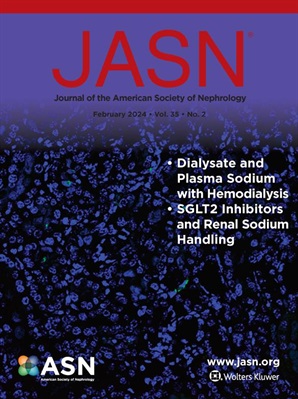男性近端小管细胞中女性偏倚基因Gsta2的表达增强可改善肾对缺血再灌注损伤的恢复能力。
IF 9.4
1区 医学
Q1 UROLOGY & NEPHROLOGY
引用次数: 0
摘要
遗传性别是肾脏损伤和修复的重要决定因素,女性肾脏通常对急性肾损伤(AKI)表现出更大的恢复能力。在小鼠近端小管细胞的两性二态基因中,编码nrf2调节的抗氧化酶的Gsta2在雌性中高度富集。在这里,我们假设增加Gsta2在男性近端小管细胞中的表达会增强对缺血再灌注损伤(IRI)的抵抗。方法为了使近端小管细胞特异性表达转基因,我们绘制并验证了指导人类HNF4A近端小管表达的增强子区域。将合成的驱动Gsta2的HNF4A增强子盒引入转基因小鼠的安全港位点,从而增强雄性小鼠Gsta2的表达。单侧肾切除后,转基因和野生型雄鼠进行IRI。iri后的结果通过检查肾功能、组织学损伤和损伤后28天的纤维化进展来评估。结果男性近端小管细胞中Gsta2表达的增强导致IRI后肾小球滤过率显著升高,纤维化重构明显减弱。损伤后4小时的早期转录分析显示,直接早期基因(Jun, Fos, Egr1)的表达减少,表明应激反应降低,DNA双链DNA断裂减少(γH2AX并入chomatin),蛋白质过氧化降低。晚期转基因肾脏表现出纤维化相关转录物(Acta2, Col1a1, Col3a1)和近端小管细胞修复失败标志物(Havcr1, Vcam1, Ccl2)的减少。结论Gsta2在男性近端小管细胞的局部表达可减少缺血再灌注损伤后的氧化损伤、损伤相关纤维化和应激不良信号。本文章由计算机程序翻译,如有差异,请以英文原文为准。
Enhanced Expression of the Female-Biased Gene Gsta2 in Male Proximal Tubule Cells Improves Renal Resilience to Ischemia-Reperfusion Injury.
BACKGROUND
Genetic sex is an important determinant of kidney injury and repair, with female kidneys typically exhibiting greater resilience to acute kidney injury (AKI). Among the sexually dimorphic genes in mouse proximal tubule cells, Gsta2, encoding an NRF2-regulated antioxidant enzyme, is strongly enriched in females. Here, we hypothesized that augmenting Gsta2 expression in male proximal tubule cells will enhance resistance to ischemia-reperfusion injury (IRI).
METHODS
To enable proximal tubule cell-specific expression of transgenes, we mapped and verified enhancer regions directing proximal tubule expression of human HNF4A. A synthetic HNF4A enhancer cassette driving Gsta2 was introduced into a safe harbor locus in transgenic mice thereby enhancing expression of Gsta2 in male mice. Following unilateral nephrectomy, transgenic and wild-type males were subjected to IRI. Post-IRI outcomes were assessed by examining kidney function, histological injury, and fibrotic progression for up to 28 days post-injury.
RESULTS
Enhancing Gsta2 expression in male proximal tubule cells lead to significantly higher glomerular filtration rates and attenuated fibrotic remodeling following IRI. Early-phase transcriptional analyses 4-hours post-injury showed reduced expression of immediate early genes (Jun, Fos, Egr1) suggesting a reduced stress response, diminished DNA double-strand DNA breaks (γH2AX incorporation into chomatin), and lower protein peroxidation. Later stage transgenic kidneys exhibited a reduction in fibrosis-associated transcripts (Acta2, Col1a1, Col3a1) and markers of failed proximal tubule cells repair (Havcr1, Vcam1, Ccl2).
CONCLUSIONS
Ectopic expression of Gsta2 in male proximal tubule cells reduced oxidative injury, injury associated fibrosis and maladaptive stress signaling following ischemia reperfusion injury.
求助全文
通过发布文献求助,成功后即可免费获取论文全文。
去求助
来源期刊
CiteScore
22.40
自引率
2.90%
发文量
492
审稿时长
3-8 weeks
期刊介绍:
The Journal of the American Society of Nephrology (JASN) stands as the preeminent kidney journal globally, offering an exceptional synthesis of cutting-edge basic research, clinical epidemiology, meta-analysis, and relevant editorial content. Representing a comprehensive resource, JASN encompasses clinical research, editorials distilling key findings, perspectives, and timely reviews.
Editorials are skillfully crafted to elucidate the essential insights of the parent article, while JASN actively encourages the submission of Letters to the Editor discussing recently published articles. The reviews featured in JASN are consistently erudite and comprehensive, providing thorough coverage of respective fields. Since its inception in July 1990, JASN has been a monthly publication.
JASN publishes original research reports and editorial content across a spectrum of basic and clinical science relevant to the broad discipline of nephrology. Topics covered include renal cell biology, developmental biology of the kidney, genetics of kidney disease, cell and transport physiology, hemodynamics and vascular regulation, mechanisms of blood pressure regulation, renal immunology, kidney pathology, pathophysiology of kidney diseases, nephrolithiasis, clinical nephrology (including dialysis and transplantation), and hypertension. Furthermore, articles addressing healthcare policy and care delivery issues relevant to nephrology are warmly welcomed.

 求助内容:
求助内容: 应助结果提醒方式:
应助结果提醒方式:


